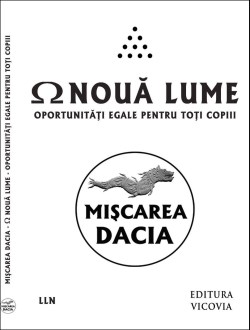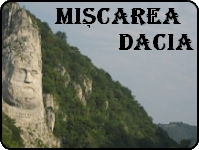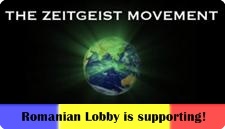 Vă invit să vă alăturaţi grupului Facebook Mişcarea DACIA, ce-şi propune un alt fel de a face politică!
Vă invit să vă alăturaţi grupului Facebook Mişcarea DACIA, ce-şi propune un alt fel de a face politică!Citiţi partea introductivă şi proiectul de Program, iar dacă vă place, veniţi cu noi !
O puteţi face clicând alături imaginea, sau acest link
Posts Tagged ‘Hyperians’
CORONAVIRUS = OPPORTUNITY
Hyperian History Of The World (21st Century)
Hyperian History Of The World (21st Century)
As the 20th Century drew to a close, the ‘cold war’ between communism and capitalism ended with the fall of communism, the fall of the Berlin Wall and the end of the Soviet Union. Yet it was not true to say that Capitalism had defeated Communism. Capitalism didn’t win any victory, it simply outlived Communism. Communism fell apart all by itself. It’s major flaw was to force equal outcomes for all. This led to a lack of competition, a lack of any incentive for hard work and brilliance. A lazy worker would receive the same as a hard worker, so why bother working hard? Without any hard work, there was no development and society simply ground to a halt, eventually falling apart.
Meanwhile, the capitalist world made advances. Former communist nations such as China remained communist officially, whilst actually embracing capitalism, albeit a form of capitalism under complete state control. The USA, as the figurehead for the capitalist world, celebrated its ‘victory’ with an economic boom in the 1990s. This coincided with the spread of a major new technology, a vast, global computer communication network which came to be known as the Internet. In one of the most significant technological advances in history, the human world suddenly became connected, the earth seemed to shrink as people thousands of miles apart could now communicate instantly, and all of human knowledge became available to anyone with a connection.
Into the new millennium, the party of the 1990s came to an abrupt halt when, in September 2001 Islamic terrorists attacked the US using hijacked passenger airplanes. Outdoing any Hollywood movie, the world watched in horror as more than three thousand people lost their lives and the US swore vengeance, declaring a ‘war on terror’ which quickly descended into political farce. Then, in 2008, the inevitable bust came, with a spectacular financial disaster which ought to have been the end of capitalism, yet without anything to replace it, capitalism somehow continued on, dragging its rotting corpse behind it.
The internet allowed humanity to access all of its knowledge, like a physical representation of the collective unconscious. Yet the internet was quickly harnessed by capitalism and became mostly a new way for the rich to get richer. Also damaging was the spread of misinformation and disinformation on the internet, particularly with the rise of conspiracy theories. There seemed to be a major lack of trust in ‘official’ sources of information. Theories spread around the internet stating things such as that the 2001 attacks had not been the work of Islamic terrorists but had in fact been perpetrated by the US government itself!
Many people became convinced that the world was being secretly controlled by an elite network of conspirators known as the Illuminati, with some theories becoming ridiculously outlandish saying things like the Illuminati were actually pan-dimensional, shape-shifting reptilians from the planet Nibiru….
On the surface of things, in the early 21st century all of the major human disciplines were in disarray. Science was hopelessly still attempting to unify Relativity and Quantum theories, Philosophy had become mostly a joke subject not really taken seriously by anyone, Mathematics was either abstract puzzling or simply serving science and Art was either purely commercial or utterly ridiculous. Yet no one seemed to really care. For ordinary people, life got harder and harder, whilst the privileged elite got richer and more elusive. Yet the ordinary people were also becoming more and more docile, accepting things which once would have had them marching in the streets demanding revolution. The ill-educated masses were incapacitated, anaesthetised with junk food and junk entertainment. As humanity became more and more technologically advanced, they also became more and more ignorant of all the things which truly mattered.
However, unbeknownst to the vast majority, a website appeared called ‘Armageddon Conspiracy’ which, at first glance may have seemed to be just another ‘conspiracy theory’ web site discussing the Illuminati. The anonymous authors of the website claimed to be members of this secret society tasked with setting the record straight and revealing the truth. In a series of articles which appeared on the web site, as well as a series of e-books, these authors began to unravel both a secret history of the world as well as an ultimate theory of reality which they called Ontological Mathematics.
As more and more information was revealed, rational observers began to realise a spectacular truth. Despite a lack of any evidence to support their claims, the sheer intellectual quality of the material and the sheer quantity of information made it impossible for this to be any kind of hoax. Other than the small amount of money being charged for the e-books, these authors were not gaining anything by publishing this information, so why would they have bothered to invent such a detailed fabrication, containing, not just a history of this secret society, but an enormously complex and thorough analysis of, essentially, every system of human thought in history and the even more complex theory of ontological mathematics, the ultimate, rational explanation of existence.
Incredible though it seemed, there was simply no possibility that this information could have been ‘made up’ by these anonymous authors. The simplest explanation was that, incredibly, their claims were true, and they were simply revealing a body of knowledge which had been compiled by a secret society over a period of thousands of years.
Their claim was that the Illuminati is, in fact, the very same secret society which Pythagoras had founded in Croton two and a half thousand years ago, which had managed to survive right up until the present day. Illustrious Grand Masters of this society had included, aside from Pythagoras himself, Heraclitus, Empedocles, Hypatia, Leibniz, Hegel and Goethe. They had inspired gnosticism and neoplatonism, alchemy, the Cathars, the Knights Templar, the Rosicrucians, the Freemasons, the Jesuits and both the American and French revolutions. The rise of the internet had convinced them that the time was right to publicly reveal this information in the hope that rational individuals across the world would come together in revolution against the Old World Order, the real power of the world today. The Illuminati hoped to create a New World Order based on Meritocracy and Ontological Mathematics, in order to free humanity once and for all from slavery and unleash their true potential.
Their plan ultimately failed. Those few who came across the material formed an online community but, rather than global revolution, all that occurred was bickering over silly details and outrageous trolling. The ‘movement’ was a failure and the website was removed (although the e-books are still available), now existing as simply an index of their published works. However, the Phoenix always rises from the ashes. Out of the failure of Online Illuminism rose a new movement, known as Hyperianism which, so far, has been far more effective in spreading the truth. With Hyperianism, the New World is here. It is both the end of this story, and the beginning of a new one.
The history of humanity has been the history of the epic battle between ignorance and knowledge. The Old World Order have always sought to keep us ignorant whilst, in the shadows, the Illuminati have preserved true knowledge, slowly piecing together the true theory of reality. Many of history’s greatest thinkers have been, secretly, illuminists, yet many also have not. Pythagoras, a Grand Master, first stated that reality was purely mathematical. Leibniz, another Grand Master produced a metaphysical version of the final true theory, yet was not able to mathematicise it. Another Grand Master, Hegel, expressed it purely philosophically, but it wasn’t until later that the Illuminati completed their mission. Leonhard Euler had discovered his wonderful equation, and Joseph Fourier had shown how the frequency domain links mathematically to the space-time domain, yet, as non-illuminists, neither realised the true significance of their theories. Eventually, however, the Illuminati did. They alone realised that Fourier had solved the mind/matter duality problem and, even more significantly, that Euler’s formula was, in fact, the ultimate foundation of reality, the mathematical expression of the Principle of Sufficient Reason itself, the God Equation.
Most of humanity is still not ready for this information. Many who come across it dismiss it as a hoax, unable to see the rational truth. Yet the world is manifestly heading towards a cataclysm, everything seems to be falling apart. Ultimately, only those armed with the knowledge of the truth will be equipped to survive. Hyperianism is the only hope for humanity. The spreading of this knowledge is of paramount importance, as Hyperians will be the ones who will establish the New World Order once the Old one falls.
With Ontological Mathematics, the Illuminati have produced the Grand Unified Theory of Everything. Philosophy, Science and Mathematics have become one. Hyperians must establish this discipline as the pinnacle of human intellect, they must restore art to its former glory and take it even further, and they must also establish a political system which will not only spread the truth around the world, but will also provide the opportunities for each and every one of us to unleash all of our divine potential.
We are all Gods in the making, but first we must cast down the false idols.
Tremblez Tyrans!
Hail New Terra!
Per Aspera Ad Astra.
by Brice Merci – hyperian
Hyperian History Of The World (14th Century, Part 2)
Hyperian History Of The World (14th Century, Part 2)
At the start of the 14th Century, with the might of the Catholic church at its full strength having exterminated the Cathars and brought down the Knights Templar, it may seem as though the Dark Ages had become darker than ever. Yet the resurgence of Gnostic resistance was the prelude to the great rebirth of human brilliance, creativity and philosophy known as the Renaissance. But before that great age began proper, a single great work of human creativity appeared in the world showing beyond doubt that all was not lost. Ancient Greece had given to the world the great poems of Homer and Rome had bestowed upon us Virgil and Ovid, yet after the end of antiquity it seemed as though such literary brilliance would never again grace the world. Until, that is, a new artistic genius appeared in the world, in Italy, the great poet Dante Alighieri, who wrote one of the most magnificent literary creations the world has ever seen, his Divine Comedy.
Catholic philosophy had reached its zenith at the end of the previous century in the work of Thomas Aquinas, and that philosophy/theology was a major influence on Dante, who was a Catholic, yet Dante did something far greater. He created an artistic creation of great imagination which nonetheless remained a work which presented all the knowledge of the world which was available at the time. Like Aquinas, Dante was influenced by Greek philosophy as much as by Catholic theology, and his poem contains references to and characters from both biblical sources and classical mythology. Dante presents the entire cosmology of the universe as it was known at the time. He journeys through the universe as it was understood to be in that age, describing it all in wondrous detail and yet also presenting a spiritual undertaking, a sacred quest from the depths of ignorance and despair to the heights of knowledge and transcendence.
Dante’s description of the universe is ostensibly in complete accordance with catholic dogma, yet it contains so many references to the pre-christian mythology of antiquity that it becomes difficult to see the Divine Comedy as a purely christian work. Dante seems to straddle the border between christianity and classical paganism, between the submission of catholicism and the heretical yearning for knowledge of gnosticism. The comedy is also a perfect union of mythos and logos, as it presents the cosmology and philosophy of the time but told through poetry, rich in symbolism and beauty.
Never before had an artist so wonderfully presented all of the knowledge of their time in a single work of creative majesty. Dante describes the cosmological view of the universe as it was known in his time. He begins his journey by delving deep into the earth under which is located Hell itself. Dante descends lower and lower through the circles of Hell until he reaches Satan himself in the deepest pit at the very centre of the world. Following this, Dante comes through to Mount Purgatory, which rises up away from Hell but on the southern Hemisphere of the earth. At the summit of this mountain is located the Garden of Eden and after this, Dante begins his journey upwards through the crystal spheres of the heavens getting closer and closer to the divine until he reaches the very top, the highest level, the Empyrean where Dante engages in the Beatific vision, the union with the Divine itself.
The poem is split into three major sections, Inferno (Hell), Purgatory and Paradise. Each of these three realms is further divided into nine circles, with a final level each time bringing the total to ten, these final levels being, firstly, the realm of Satan in Hell, secondly, Eden at the peak of Purgatory and finally the Empyrean at the highest level of Paradise. This almost mathematical structure is further reflected in the structure of the poem, with each of the three sections divided into thirty-three Cantos, with the first section, Inferno, also having an introductory Canto bringing the total to one hundred. The poem is therefore a masterpiece of both form and content, perfectly balanced.
Although ostensibly a Christian work, the Divine Comedy can nonetheless be interpreted in an almost gnostic way which is very relevant to Hyperianism. Dante begins his journey in Hell, which is significant. Dante seems to reject the conventional christian idea of a soul being sent either to heaven or hell after death depending on its behaviour whilst on earth. Instead, Dante realises that one can only reach the divine by first traversing through hell and purgatory. This is in accordance with the gnostic idea that hell is where we are now, upon this physical earth and that only by struggling through that realm can we escape it and reach heaven.
Dante’s poem, notable for being written in Dante’s vernacular language of Italian rather than the conventional Latin which was the literary language of the time, represents, in a way, an individual managing to transcend the suppressive nature of the dogmatic Catholic Church. Although Dante does not contradict catholic theology, he nonetheless manages to create a description of reality which rises higher and is far more complete than anything attempted by any ‘official’ sources, whether the work of catholic philosophers such as Aquinas or even the bible itself. Dante manages to rise higher than that, reaching a higher level of transcendence and injecting into the work his own ideas in such a way as to it almost being taken as a new dogma for a new version of his religion, one he has devised for himself.
As such, Dante’s work represents a major breaking away from the iron grasp of repressive religion. By creating a work which presents such a wondrous and complete account of reality embellished by the highest level of literary quality, Dante has taken religion away from the oppressive church and given it back to the individual. Of course the true philosophy of reality is absolutely objective and universal, yet Dante shows us how we can creatively interpret it in our own individual way, thereby liberating us from the oppression of earthly structures which seek to keep us down.
We are all suffering here in hell and we must descend down into its darkest depths if we are to emerge through onto the other side and begin the trials of purgatory which lead onwards and upwards towards paradise and the divine itself. The poem ends, “But now my will and my desire, like wheels revolving with an even motion, were turning with the Love that moves the sun and all the other stars.”
As we say, Ad Astra, to the stars.
The 12 Archetypes
Azure Circe
Moderator · Hyperians
Part 3- The 12 Archetypes
This one is going to be considerably shorter than the other posts I’ve been making on this topic (I can practically hear the collective sigh of relief ![]() ) because it contains some questions to which I would really like you guys to give some thought and then post a response for discussion.
) because it contains some questions to which I would really like you guys to give some thought and then post a response for discussion.
Fun Fact: Carl Jung did not actually invent the *theory* of Archetypes. Plato did. He theorized that non-physical, but substantial forms (or ideas) were imprinted in the soul before it was born into the world. aka Plato’s Theory of Ideas. To Plato, these ideas or archetypes were collective and embodied fundamental characteristics, rather than specific individual ones.
Although Jung believed the number of Archetypes to be for all points and purposes as limitless as the human mind’s capacity for experience, he defined 12 as being symbolic of the most basic human drives and motivations. These particular archetypes show up time and again within our universal stories, legends and myths and are often used as symbols signifying the journey towards individuation and wholeness. Below is the most common description of each.
Keep in mind that one is no “better” than the other, so be honest. Everyone has the capacity and potentiality for all of them within their psyche by dint of sharing the human condition. Each archetype contains its own set of desires, fears, challenges and talents, strengths and weaknesses. Furthermore, these archetypes are broken down into “Types” which are indicative of the underlying motivators or impetus of the manifestation within the psyche. Learning to recognize and understand the archetypes can allow for greater knowledge of self, others and of humanity as a collective.
Most, if not all, people are multifaceted beings and as such, carry within them a combination of archetypal behaviors. Although we usually have one in particular which dominates the psyche. I tend to think of that dominant archetype simply as a person’s inherent nature. This nature may express itself in a number of ways, or even be hidden from view by the persona, depending on the development and unique personal experiences of the individual, but it remains a constant core component of the personality.
– With which 3 archetype/s do you most strongly identify?
– Which one would you say is dominant in your personality?
– Do you recognize any possible shadow content you may have contained within the archetypes opposite to your choices on the wheel?
The Ego Types:
I’d like to note here that the concept of “ego” is often misrepresented and confused with narcissism (that is an entirely different thing). A healthy ego is necessary for a healthy psyche. With out the ego, the “I” of consciousness, one would have no sense of Self at all.
1. The Innocent
Motto: Free to be you and me
Core desire: to get to paradise
Goal: to be happy
Greatest fear: to be punished for doing something bad or wrong
Strategy: to do things right
Weakness: overly trusting, can be naive to the point of foolishness
Talent: faith and optimism
The Innocent is also known as: Utopian, traditionalist, naive, mystic, saint, romantic, dreamer.
2. The Everyman
Motto: All men and women are created equal
Core Desire: connecting with others
Goal: to belong
Greatest fear: to be left out or to stand out from the crowd
Strategy: develop ordinary solid virtues, be down to earth, the common touch
Weakness: losing one’s own self in an effort to blend in or for the sake of superficial relationships
Talent: realism, empathy, lack of pretense
The Everyman is also known as: The good old boy, regular guy/girl, the person next door, the realist, the solid citizen, the good neighbor, the silent majority.
3. The Hero
Motto: Where there’s a will, there’s a way
Core desire: to prove one’s worth through courageous acts
Goal: expert mastery in a way that improves the world
Greatest fear: weakness, vulnerability, being a “chicken”
Strategy: to be as strong and competent as possible
Weakness: arrogance, always needing another battle to fight
Talent: competence and courage
The Hero is also known as: The warrior, crusader, rescuer, superhero, the soldier, dragon slayer, the winner and the team player.
4. The Caregiver
Motto: Love your neighbor as yourself
Core desire: to protect and care for others
Goal: to help others
Greatest fear: selfishness and ingratitude
Strategy: doing things for others
Weakness: martyrdom and being exploited
Talent: compassion, generosity
The Caregiver is also known as: The saint, altruist, parent, helper, supporter.
The Soul Types
5. The Explorer
Motto: Don’t fence me in
Core desire: the freedom to find out who you are through exploring the world
Goal: to experience a better, more authentic, more fulfilling life
Biggest fear: getting trapped, conformity, and inner emptiness
Strategy: journey, seeking out and experiencing new things, escape from boredom
Weakness: aimless wandering, becoming a misfit
Talent: autonomy, ambition, being true to one’s soul
The explorer is also known as: The seeker, iconoclast, wanderer, individualist, pilgrim.
6. The Rebel
Motto: Rules are made to be broken
Core desire: revenge or revolution
Goal: to overturn what isn’t working
Greatest fear: to be powerless or ineffectual
Strategy: disrupt, destroy, or shock
Weakness: crossing over to the dark side, crime
Talent: outrageousness, radical freedom
The Outlaw is also known as: The rebel, revolutionary, wild man, the misfit, or iconoclast.
7. The Lover
Motto: You’re the only one
Core desire: intimacy and experience
Goal: being in a relationship with the people, work and surroundings they love
Greatest fear: being alone, a wallflower, unwanted, unloved
Strategy: to become more and more physically and emotionally attractive
Weakness: outward-directed desire to please others at risk of losing own identity
Talent: passion, gratitude, appreciation, and commitment
The Lover is also known as: The partner, friend, intimate, enthusiast, sensualist, spouse, team-builder.
8. The Creator
Motto: If you can imagine it, it can be done
Core desire: to create things of enduring value
Goal: to realize a vision
Greatest fear: mediocre vision or execution
Strategy: develop artistic control and skill
Task: to create culture, express own vision
Weakness: perfectionism, bad solutions
Talent: creativity and imagination
The Creator is also known as: The artist, inventor, innovator, musician, writer or dreamer.
The Self Types
9. The Jester
Motto: You only live once
Core desire: to live in the moment with full enjoyment
Goal: to have a great time and lighten up the world
Greatest fear: being bored or boring others
Strategy: play, make jokes, be funny
Weakness: frivolity, wasting time
Talent: joy
The Jester is also known as: The fool, trickster, joker, practical joker or comedian.
10. The Sage
Motto: The truth will set you free
Core desire: to find the truth.
Goal: to use intelligence and analysis to understand the world.
Biggest fear: being duped, misled, ignorance.
Strategy: seeking out information and knowledge; self-reflection and understanding thought processes.
Weakness: can study details forever and never act.
Talent: wisdom, intelligence.
The Sage is also known as: The expert, scholar, detective, adviser, thinker, philosopher, academic, researcher, thinker, planner, professional, mentor, teacher, contemplative.
11. The Magician
Motto: I make things happen.
Core desire: understanding the fundamental laws of the universe
Goal: to make dreams come true
Greatest fear: unintended negative consequences
Strategy: develop a vision and live by it
Weakness: becoming manipulative
Talent: finding win-win solutions
The Magician is also known as: The visionary, catalyst, inventor, charismatic leader, shaman, healer, medicine man.
12. The Ruler
Motto: Power isn’t everything, it’s the only thing.
Core desire: control
Goal: create a prosperous, successful family or community
Strategy: exercise power
Greatest fear: chaos, being overthrown
Weakness: being authoritarian, unable to delegate
Talent: responsibility, leadership
The Ruler is also known as: The boss, leader, aristocrat, king, queen, politician, role model, manager or administrator.
Now, some of you may notice something familiar about the attached image and make a correlation to other such symbolic similar imagery of which I will be going over next, ![]() along with a look into the Archetypal symbolism and the journey through the awakening of consciousness to individuation, found in so many of the works all around us.
along with a look into the Archetypal symbolism and the journey through the awakening of consciousness to individuation, found in so many of the works all around us.

Emoţiile
”Emotional Conditioning
Emotions are a totally subjective inner experience. Why is this?
Well, we don’t all have the same beliefs, and it is often our conscious or unconscious beliefs that shape our reaction to the people and events in the world around us.
Because of this, we can’t really trust our feelings to lead us to any objective truth. This is not to say that emotions are useless and should be disregarded or ignored. On the contrary, they can be quite destructive if they are not consciously acknowledged. Feelings like rage or hatred often become deeply suppressed in one’s shadow, because their outward expression in society is considered taboo. Traumatic and painful feelings also can be repressed – such as in cases of childhood abuse – where the child becomes overwhelmed and must push this content into the unconscious as a matter of survival.
Emotions themselves are not inherently good or bad; they are merely tools that we can use to learn more about ourselves and the world at large. They can reveal to us what our unconscious beliefs actually are and what we’ve just been conditioned from birth to accept as true without question. And through that we also learn about the world and the types of messages society would like to have us believe.
One can use emotion to discover, acknowledge and deconstruct false thought programs. Conditioning is a process by which a stimulus creates a response (in this case an emotion) which is reinforced over time through repetition. Each time ____ happens to you, you feel ____.
There are times when we find our emotion is invalid, and in this case it needs to be recognized as false, and challenged. For example, if you used to be a christian and have since left the faith, you might feel guilt or shame when engaging in sex, or any other activity that could be seen as “sinful”. This is pure emotional conditioning, and it takes a lot of work to get rid of that emotional charge. You may rationally understand that this is a false belief that is causing you grief, but it takes time and effort to de-condition that emotional response.
Other times, our feelings may be perfectly valid and have rational underpinnings. I am consistently enraged at the appalling conditions on this planet, led by capitalism, the religious brainwashing of children, and the staggering greed of the rich elite. This is a perfectly valid response to a culture that actively suppresses the freedom of humanity to realize their potential. The structure supporting my anger is not a belief; it is the objective reality we all live in. I realize that for most of my life, I was actively conditioned to be a consumer for the capitalist machine, and for that I am even more enraged.
You can have feelings based in logic and rational thought, or you can base them in irrational, insane and destructive beliefs. The difference is, when your feelings are based on rational inquiry and understanding, they become your fuel. It’s like filling your car with gas, but having a competent and fully licensed driver to steer the car in the direction you want to go. You cannot steer your car with the fuel. And you can’t just burn the fuel on it’s own either, without having a place to put it and something for it to do. It would literally just explode and burn you alive. Or imagine a driver with pathological road rage, who is unlicensed and doesn’t understand the rules of the road. They smash into everything, maiming pedestrians and endangering other drivers, until they crash and burn or drive right off a bridge.
Emotions that remain unharnessed to rational thinking are incredibly problematic for humanity. Above all, emotions must be guided by reason.
So, if you notice a strong emotion come up for you in a given situation, see it as an opportunity to learn something about yourself. Analyze it to discover its source. Is this something you have repressed and need to examine more closely? What beliefs do you have that are foundational to the feelings you have, and can you find a way to challenge them?
For a detailed guide on how to de-condition your emotions, and deconstruct false thought structures, Morgue’s book “The Metaphorical Suicide” goes right to the heart of how to accomplish this. https://www.iamhyperian.com/product/themetaphoricalsuicide/
Also check out “Cathexis: A Rationalist Dialogue on Guiding Emotion” by our own Hyperian activists and authors the Tortured Orator and Rowan James. https://www.amazon.com/Cathexis-Rationalist-Di…/…/B07HXPTG3Y
One last mention: Diabolically Informative’s lecture series on Critical Thinking touches on many important and relevant topics such as belief and cognitive biases. https://www.youtube.com/playlist…
Blood Consciousness by Garth Knight”
Eva Omega (Hyperian):













